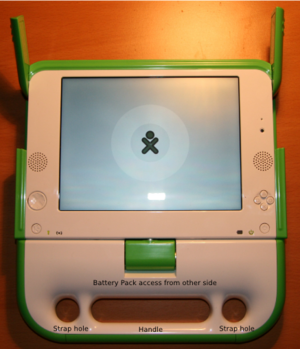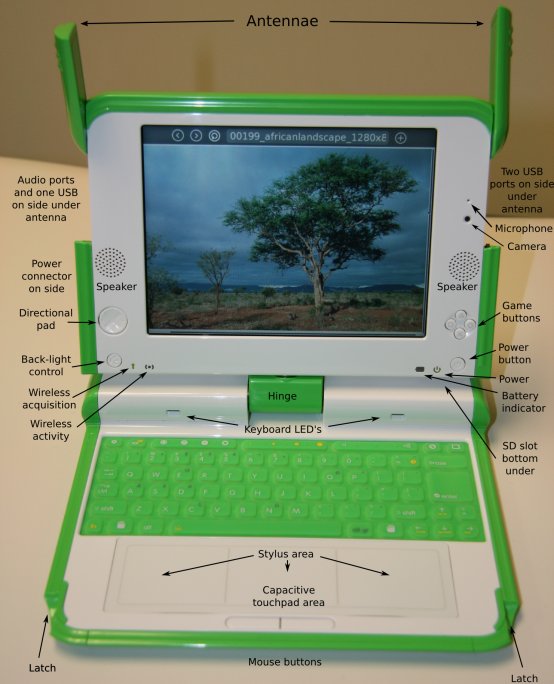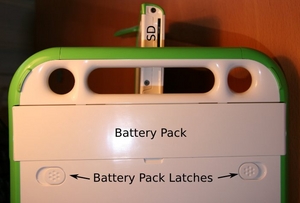Developers program/lang-ja
- This is an on-going translation
OLPC開発者向けプログラム
開発者プログラムに参加するための手順についてはここをご覧下さい.
あなたがしようとしていることの多くはエミュレータを使って行うことができる場合が多いです。
- あなたのシステム用にエミュレータをダウンロードし走らせるにはエミュレーションのためのOSイメージをご覧下さい。エミュレーションには、QEMU, Paralles, そしてVMWareなどの様々な選択肢があります。
- 個人の活動成果やライブラリコレクションもダウンロードすることができます。
- ソースコードの保管場所とバグトラッキングシステムはここにあります。
上記の補足情報として、該当のリリース関連情報としてハードウェア・ソフトウェア・ライブラリリリースノートをご覧下さい。
概要と心の準備
OLPCシステムは、おおよそ5年程前の一般的なラップトップと比べ際立った相違点があります。すなわち、私たちがベースとしているシステムソフトウェアは以前よりもより多くのことができるようになりました。Linux環境は今では言語記述において以前は手の届かなかった国際化に対応しており、遥かに高品質なレンダリングと、そして何よりもアプリケーションの選択肢が大きく広がりました。
しかしながら代償もあります。「ムーアの法則」はメモリの利用やCPUの利用において私たちを無頓着にしてしまいました。この状況は利用可能なソフトウェアの"フットプリント(サイズと必要リソース)"に対し難しい選択を迫ることになりました。OLPCラップトップは内蔵ストレージとして512MB(のフラッシュメモリ)しかありません。そしておそらくもっと深刻な制約として128MBしかないRAMとシングルコアプロセッサであることが挙げられます。過去5年間にわたり、これらの問題に対してOLPCコミュニティはより神経質になってきました。そして作業はこの"膨れ上がる"サイズと全般的な処理効率改善の作業にむけ順調に推移しています。
私たちが基盤とする技術の選択は、ソフトウェアの能力において、見渡す限り世界的な規模での"ユーザの使用感"において最も優れたものを達成すると予測されてきました。この思いは私たちにGTK+とPango(そしてグラフィカルユーザインタフェースの基盤としてCairoも含め)を選択させるに至りました。なぜならば、複雑なスクリプト群におけるPangoの処理能力は現在ではフリーソフトウェア技術の中で最も進んだものです。もちろんその他のツールキット群も利用可能ですが、メモリとflashのサイズに対する代償が大きいのです。特に今日では、私たちが直ちに直面する多くの言語表現に対しローカライズ作業を要す(それらはタイ語とアラビア語を含みます)それらを基盤としたソフトウェアの能力において代償が大きいのです。従って、私たちのベースシステムの標準的部分としてその他のツールキットを含めることは問題を抱えることになり、そして内蔵システムにおける利用感は、複数のツールキットを含めることが恐らく間違いなく全体的な利用感を損ねることになりかねないということを示しています。
Bテストシステム
私たちは"Bテスト"のために、(3つのビルドの)2つの完全なOLPCラップトップ完成筐体のビルドを作ってきました。
一般的に外部ベータテストの前に内部的に1つないしは2つのビルドを用意します。そして私たちのBテスト-1は電気回路の真のベータテストであり、一方アルファテストは新しいスクリーン、タッチパッド、工業デザイン、そしてキーボードのテスト用でした。このプロセスは開発サイクルにおいて通常利用可能になるペースに比べより早いものです。そしてそれに応じて、少々荒いものでもあります。
Bテスト-2ハードウェアは電気回路、新しいスクリーン(今回はディフューザーがスクリーンをより改善しています)、そしてタッチパッドのためのベータテストを継続中です。工業デザインに関してはBテスト-1に比べほんの少しだけ改善されています。すなわちBテスト-1より得られた機構的改善における要改善点はBテスト-2では今回は盛り込まれていません。そしてBテスト-3ではBテスト-1やBテスト-2よりも著しく耐環境性に関して向上する見込みです。
Bテスト-1マシーンの開発者プログラムにおける注目点はシステムにおけるスクリーン、タッチパッド、そして/あるいはカメラの使い勝手を知るためのGUIに関係したプロジェクトにおけるソフト開発です。このようなテストはベアPCボードではすぐに確認するにはなかなかやっかいな項目でした。
Bテスト-2の注目点は、メッシュネットワークのテストプロセスを開始することであり、(準備作業は完了はしましたが、これを書いている現時点ではサスペンド・リジューム機能はまだ動作していないのですが)このサスペンド/リジューム機能についても作業を実施しています。
マシンはまたプロジェクト最初のターゲット国へ割り当てられる予定ですが、個人のフリーでオープンソースのデベロッパーやOLPCの目標を拡大することへの貢献に興味を持っている研究組織は目標としていないため、このプログラム下の活動には割り当てられません。
Bテストユーザに対しOLPCが期待すること
リリースノートをお読みください!
The BTest-1 build has been distributed: the BTest-1 Release Notes describes the state of the first build of machines. The BTest-2 build is starting distribution as of February 12. The BTest-2 Release Notes describes the state of the second build of machines. The BTest-4 build completed in late June, and distribution of these improved systems has begun, first to developers, and when the Trial-2 software is ready, they will be distributed for later trials.
The software will run on BTest-1, BTest-2 and the ATest boards; please read the OLPC Software Release Notes.
バグのレポート方法
Note that our process is a fully open one: in a "conventional" beta test program for a product, you would have been asked to sign a non-disclosure agreement, and not disclose any of the problems you might have, or even be aware of problems other beta testers might be having. Usually, such a hardware beta test is done later in the program after more extensive testing has been done than has been done here.
The early beta test hardware means a much higher probability of hardware problems than later beta test or production hardware. The design is undergoing stress testing at elevated temperature, cold, vibration, shock, and humidity as well as many other tests.
Components that are fine on paper, may not work well in practice, either by defects in the design of the components or in their use. Beta testing is also used to test different manufacturer's components. Whenever possible in high volume products, components are "multiple-sourced", and the same nominal kind of part from different manufacturers tested for compatibility. This is to ensure steady supply, even if a particular manufacturer later starts having manufacturing problems, alternatives will be available. Examples in our hardware include camera supplier, RAM supplier, PCB supplier, to name just a few. On the ATest boards, for example, we discovered several components that we do not want to use in production, and we can expect similar issues during BTest. A component's design may be new, and have its own design or manufacturing problems to be resolved (e.g. the writing pad problem we note below). Errors can be made in assembly. Errors can be made in design or component selection. A particular lot of components may be defective. The purpose of beta test, particularly for a high volume product, is to discover these problems, long before volume production, analyze the failures completely, and, by understanding the root cause of each failure, be able to eliminate or prevent these problems in the production units. If you have a hardware problem, OLPC may ask you to return the machine quickly for failure analysis; we will do our best to get you a replacement promptly.
We expect that you will quickly enter new hardware and software problems you encounter into our bug tracking system, so that the problems can be tracked and resolved. Please include the firmware version you are using -- displayed at power on time on the second line: e.g. "OpenFirmware CL1 QA62 Q2A"; the QA62 is the firmware version--the operating system build number--which is displayed at the end of the boot process--and the serial number of your machine--found under the battery; this will help us analyze your problem and resolve it.
While duplicate bug entries are inevitable, searching to see if the problem has already been reported will be very helpful to us. Problems cannot be fixed if we don't know what you encounter, or how often they are encountered; if you find clearly the same problem as some one else, it is still helpful to know how often it is occurring, or any additional details you know. Add such information to the bug reports. Err by too much reporting, rather than too little. A pattern may emerge among the reports or comments on a bug, or we may have a much better idea how severe a problem is and be able to better prioritize its resolution. Bugs are good. Each bug is much easier to fix now than later.
ハードウェア
ハードウェアについてのユーザガイド
You are using a system during test, well before when you would have the opportunity to use a "normal" commercial product. This is to allow both hardware and software testing to start, since our system is significantly different than conventional laptops (e.g. the screen, power management, ruggedness), and will be used in very different environments. You will see "behind the curtain" (and be part of) the process that computer system manufacturers hide from you: the good, the bad, and the ugly process of hardware and software debug.
The picture on the right locates most of the features of the machine. To open the machine you must first unlatch the antennae and then lift it open.
To rotate the screen to transform to ebook mode, the screen must be in the 90% upright position. It can only rotate one of two directions to the point where the screen can again be closed down over the keyboard.
The battery pack is located under the screen underneath the keyboard, and is released by two slide latches as seen in the lower thumbnail. You can also see the SD slot clearly. Note: the plastic will be textured in later builds so the surface of the machine will not be shiny.
}
Bテストマシーンで心しておくこと
Please carefully read the BTest-1 Release Notes or BTest-2 Release Notes and the BTest-1 Demo Notes.
If you get a BTest machine(s), expect to get (a) box(s) with:
- one or more BTest systems, with localized keyboards if available
- one AC power adapter for each machine (to the extent possible by our logistics and crystal ball gazing) which will have the right plug type for your country if available
- one battery pack for each machine
- factory or OLPC pre-load of some version of the software: you should plan to immediately update the software to a current version upon arrival. This has been made extremely easy with the Autoreinstallation image.
プロジェクトにおける情報交換の場所
If your interest is primarily on doing some systems level or on applications level coding, then join one of the projects on our Hosting Wiki. We have much more flexibility, bandwidth and CPU available than alternatives like SourceForge, and your project won't be as lost among thousands of other projects unrelated to OLPC. If your project has aspects related to OLPC, but is primarily part of some other project (e.g. GTK+, X11), we're also happy to provide more limited OLPC related facilities, such as bug tracking and our wiki.
ハードウェアスケジュール
In this first generation of boards, which we call A-Test boards, the hardware is fully functional except that video is VGA out, rather than using a flat panel with the DCON chip which appears in the BTest systems.
Packaged BTest-1 machines were built in late November. The BTest-1 systems are fully functional, but use an Altera FPGA in place of the CaFE ASIC which is present in later builds, for NAND flash, camera, and SD interfaces. This FPGA has lower performance and consumes much more power than the CaFE ASIC does. Another build (BTest-2) occurred in late January using the completed CaFE ASIC. The third BTest-3 build, in larger quantities, occurred in May. BTest-2 systems were used in the earliest trials. BTest-4 was built in late June, is undergoing distribution first to developers, and once the Trial-2 software is ready, will be distributed to later trials.
目標
Our goals will vary as the hardware matures. For the BTest systems we need the most help on:
- power management in the device drivers: for us, every joule matters, and a simplistic "oh, we mostly have most of a chip turned off, maybe" isn't good enough. We want to know that every possible power savings has been realized, and that suspend/resume is rock solid and blindingly fast.
- fast suspend/resume: We must go beyond the current state of the art as discussed at the power management summit.
- modal operation: if certain applications are full screen, the system should automatically suspend and resume whenver idle for more than a short period.
- variable speed display driving: (aka: mode change on the fly), again, to save power.
- wireless: we will be deploying mesh networking. Serious experimentation in this area is in order, to shake down the drivers and to gain experience in its behavior in differing conditions (e.g. rural areas with low noise characteristics; busy metropolitan areas). We understand that to do serious tests, more than a single board will be needed. Please be realistic in your expectations: two boards is not interesting; two hundred boards can't be provided.
- compiler optimization: if you are a compiler wizard, we understand that the Geode lacks a specific back end code scheduler, which limits performance, particularly FP performance. We'd love to see work go on in this area which would help everyone.
- tickless operation: there are patches out of tree about to be integrated into Linux that allows Linux to function without periodic tics; we've been experimenting, and while our tick rate is probably the lowest yet observed on a Linux system, it can and should go further. Nothing in the system should poll!
- power management desktop interaction: applications need to be better aware of their power usage and requirements, and communicate this better to the system.
- The OOM (out of memory) killer is naive, to say the least.
- Sugar optimization: While the Sugar environment will get substantially faster as soon as we deploy a rebuilt Python 2.5, further work, particularly on python startup, is in order.
- Sugarizing applications: There are many applications that with minimal work can be made to work well in the Sugar environment for young children. We encourage you to pick one and help out.
- Remote display: we have begun work on a low cost projector. Making it easy to remote applications is well worthwhile. There are a number of ways (and difficulties) of doing this, so there are immediate techniques available, along with much more sophisticated ways of advancing the "state of the X Window System art", depending on your inclinations and abilities.
- Educational applications of all sorts.
- Server based tools for schools and support of the laptops.
We're sure you are brighter than we are and have seen what we're missing in the above list.
You can contribute in many areas which do not require hardware. For example:
- memory usage: many applications and toolkits waste and/or leak memory. Fixing these will help everyone and most easily done on conventional systems.
- performance optimization: fixing memory usage will usually result in faster code.
- toolkit adaptation: the display's effective resolution will change from grayscale to color mode and back. Toolkits and applications need to be able to adapt, and themes that work well in both modes verified.
- UI: most of the user interface work can be done today on conventional Linux desktops. But our system will also have an e-book mode, with dual 4-direction keys and enter. Key applications will need updating to work well in this environment (e.g. evince, web browser). Testing application's behavior under grayscale conditions and making whatever changes are needed would be helpful.
- Applications: goes without saying. The "Sugar" environment under development can be run on conventional desktops, and many applications should be simplified and optimized for our systems. Our primary audience are younger children, rather than the middle and high school students that have been the primary child users of computers.
- IPv6 support, and service discovery, which are very important to us.
- Security: SELinux or other techniques may be a way to protect against Day 0 attacks; as a large ecosystem of similar machines, it is something worth seriously worrying about.
We will give preference for hardware to proposals that require access to the OLPC hardware to make progress; BTest requests should either require mobile use of the systems and focused on GUI and applications where access to our new screen is needed.
品質管理
We're looking for people able and interested in helping in development. The qualifications needed depend strongly upon where you are interested in working: for example, people working on BIOS/boot paths should be seriously "friends of the electrons", and not scared of JTAG and similar kinds of debugging.
Most driver work takes normal driver debugging skills, though getting power management right can be more challenging than most driver development.
Window system development requires X experience, and so on; applications, experience in developing those or similar applications, and so on.
支援の方法
dev.laptop.org
ソースコード管理システム
Since both the kernel and the X Window System use git as their development source code management systems, and we work on both, git is our SCM of choice. You can see the git trees hosted at dev.laptop.org.
The Fedora kernel is maintained at that project. For BTest-1 we are using a kernel from the olpc-2.6 tree, rather than a Fedora kernel. This may change at some future date.
Source RPMs for most OLPC-specific versions of code are also available from RedHat.
バグ追跡システム
OLPC maintains a bug tracking system called trac, which is also a wiki (though we discourage use of it as a wiki). To use it, you need to create an account for yourself. You can query it for open (or closed) bugs.
Wiki
The main public OLPC wiki is available for use to write about any ideas or efforts related to the project; or to categorize and develop content for the laptops. Some pages (prominently marked) are maintained by the core OLPC team. We prefer this wiki to the Trac wiki for most writing.
重要な技術に関連する組織へのリンク
OLPC depends on a number of key technologies and projects, including:
お問い合わせ
e-mailについてのお問い合わせはContact OLPCをご覧下さい。
郵便による送付については下記まで:
- One Laptop per Child
- P.O. Box 425087
- Cambridge, MA 02142
- USA
IRC Chat
私たちは主にIRCインスタントメッセージングを利用しており、irc.freenode.netのチャネル#OLPCと#sugarにいます。
ソフトウェアのインストール
ハードウェアを受け取った方は
Note: when you first receive the system, please immediately update the system to current software, as documented below in the NAND Flash and BIOS Re-installation section.
The BIOS (LinuxBIOS + OpenFirmware as bootloader), Linux itself, and the OLPC software stack were installed at the factory on the BTest systems; however, this is intended as testing of the systems and practice for later rather than for serious use. In the time since we gave the system to Quanta for manufacturing until you receive a system, a number of key bugs have been fixed, and other problems resolved.
システムの更新
When you receive the systems, and occasionally afterwards during beta test, the software and/or firmware (BIOS), may need to be upgraded. We expect that during deployment addition of local software and content or total replacement of the factory installed software will be normal.
BテストシステムのOSイメージをアップグレードする方法
NANDフラッシュとBIOSの再インストール
Follow the autoreinstallation image directions; this makes updating many machines very easy, as easy as inserting a USB key and rebooting the system.
(A summary of the procedure is outlined below. Upgrading the OS on NAND flash is now a three step process:
- Download a zip file;
- Unzip the contents, creating a directory named "boot" on a flash key or disk drive;
- Plug in the USB flash key or USB disk and reboot.
The Forth scripts used by Open Firmware will update the SPI BIOS bootflash, fix the manufacturing data error, and installs an image onto NAND flash, without further intervention. It is has been made as simple as possible.)
FlashもしくはDiskにLinuxをインストールする方法
(Detailed instructions are here: Build_images.)
The first step is to obtain a USB disk, install an OS image to the disk, and boot the laptop off of the USB disk. Instructions for installing an OS image to the USB disk can be found here. Once the laptop has booted off the USB disk, the image that's on the laptop itself can be upgraded (this is only recommended when upgrading an old ATest system running an old BIOS). Instructions for upgrading the internal OS image can be found here.
Manual updates to the BIOS and wireless firmware should happen automatically when using a new OS image.
XOに応募する方法
もしあなたがエミュレータでの作業を試み、開発を実施するための物理的なXOマシンを必要とする場合は、developerアットマークlaptopドットorgのメールアドレスへ下記の情報と共にメールをお送りください。
- 名前
- Emailアドレス
- 会社名(もしあれば), 大学名/学校名
- 送り先住所と指定事項
- 名前,
- 住所, (私書箱は不可です。)
- 市,
- 郵便番号,
- 国,
- 電話番号, (運送業者のために必ず必要です。)
- その他何か送付の際の指示があれば
- 電源アダプタの仕様(注意:ある国においては正しい電源アダプタを必要とする全てのデバイスについて税関が非常に神経質です。例えばアルゼンチンは特に小うるさいです。)
- 希望キーボードレイアウト(できるだけ要望に沿えるようにいたします。).
- マシンの活用に関するあなたの計画についての説明。"XOで遊べたら素敵だし、あなた方のためにいろいろとデモをします"といった内容よりも、このシステムにもたらす具体的な成果と共にはっきりとした提案をいただいたほうがより有望です。
- 必要とするマシンの数
- ハードウェアやソフトウェアに関するあなたの経験
使っていないマシンについて
もしあながたOLPCの取り組みに寄与する時間がもはや確保できない場合は、どうぞ貸与中のマシンを返却くださいますようお願いします。全てのAテスト用のボードについてはあなたの貢献の記念としてお手元に残してくださって結構です。


